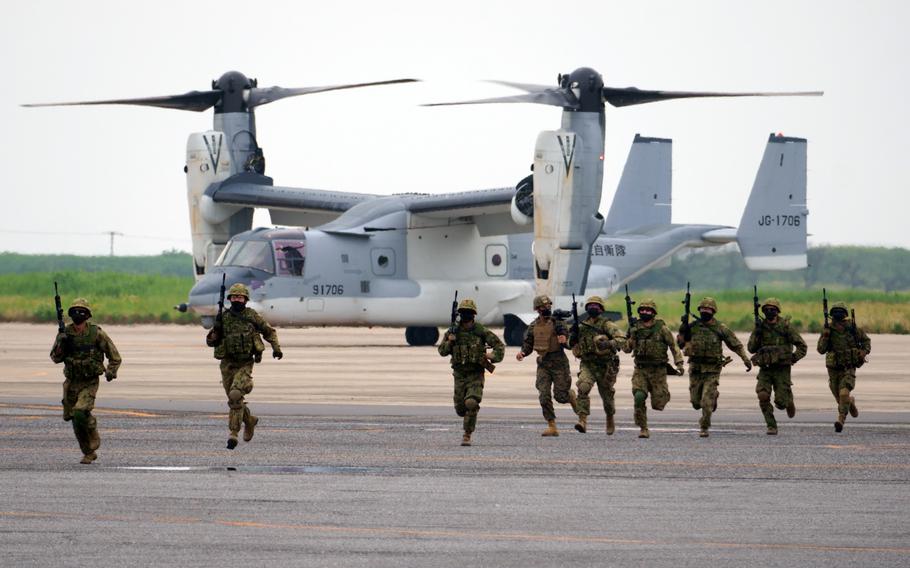
A Marine Corps MV-22 Osprey lands near Mount Fuji while Japan Ground Self-Defense Force soldiers secure the area during training on March 15, 2022. (Akifumi Ishikawa/Stars and Stripes)
YOKOTA AIR BASE, Japan — The U.S. Marine Corps has resumed flying its MV-22B Ospreys days after the U.S. military grounded the entire tiltrotor fleet due to safety concerns, according to a 1st Marine Aircraft Wing spokesman.
“The Deputy Commandant for Aviation has directed the resumption of non-essential MV-22 Osprey flight operations after a thorough fleet review conducted during the operational pause,” Maj. Joseph Butterfield, a spokesman for the Okinawa-based 1st Marine Aircraft Wing, said by email Wednesday.
The Department of Defense grounded its entire tiltrotor fleet Monday while investigating whether weakened metal components played a role in a recent near-crash. The Marine Ospreys had been grounded since Friday.
An investigative report published last month by The Associated Press found that Osprey parts are wearing out faster than expected and the hybrid aircraft design itself is contributing to many of the accidents.
U.S. Air Force and Japanese tiltrotors remained grounded Wednesday, according to officials from both countries. U.S. Navy spokespeople did not immediately respond to emails requesting the flight status of the service’s Ospreys that day.
The Marines’ MV-22B flight operations are cleared to resume with certain temporary restrictions in place and exemptions for mission requirements, Butterfield wrote.
“This guidance will be revisited following an interservice review later this week,” he said.
The Air Force Special Operations Command has not resumed CV-22B flight operations, Capt. Richard Caesar, a spokesman for the Okinawa-based 353d Special Operations Wing, said by email Wednesday.
“We are in close coordination with the V-22 Joint Program Office and aware of their operational pause recommendation,” said a statement attached to his email.
Concurring with the recommendation, AFSOC commander Lt. Gen. Michael Conley has directed a pause for all CV-22 flight training, the statement said.
“A pause in flight training operations allows time and space for us to understand what happened in the most recent event before we accept risk with unknown variables,” the statement said.
The Japanese military’s 17 Ospreys were grounded Tuesday with exceptions only for mercy flights such as disaster relief, Kimihito Aguin, the spokesman for Japan’s Ministry of Defense, said at a news conference that day.
“Ensuring flight safety is the top priority for Osprey flight operations within Japan,” he said, according to a transcript on the ministry’s website. “We will carry out confirmation work to ensure safety after receiving detailed information from the U.S. side.”

Soldiers storm out of a Japanese V-22 Osprey during training at Camp Kisarazu, Japan, June 16, 2022. (Akifumi Ishikawa/Stars and Stripes)
The Ospreys remained grounded Wednesday, according to a Japan Ground Self-Defense spokesman. Some Japanese government officials may speak to the press only on condition of anonymity.
The Japanese Ospreys had resumed flying on Nov. 15. The fleet was grounded in late October after one of the aircraft tilted violently during takeoff and struck the ground in Okinawa prefecture.
The pause to U.S. Osprey flights was recommended last week “out of an abundance of caution” by Vice Adm. Carl Chebi, the head of Naval Air Systems Command, which runs the Osprey program for the military.
A near-crash on Nov. 20 at Cannon Air Force Base, N.M., had similarities to a crash off the coast of Japan in November of last year that killed eight Air Force Special Operations Command service members.
That tragedy led the U.S. military to ground its fleet of about 400 Ospreys between Dec. 6 and March 8 while investigators examined the cause.